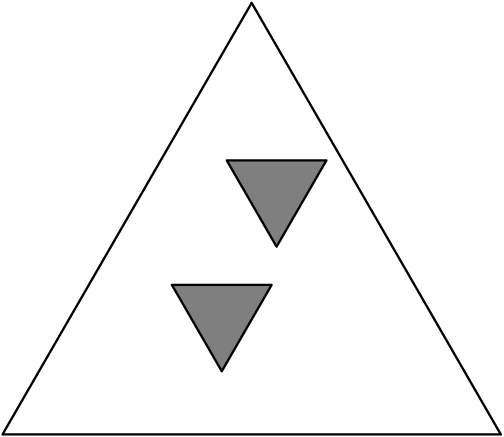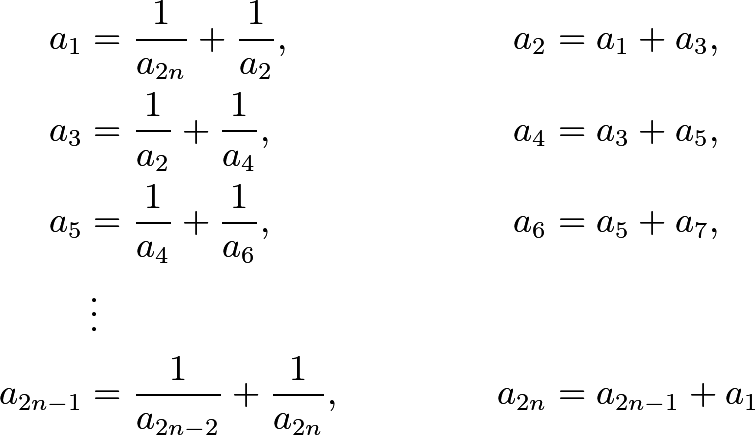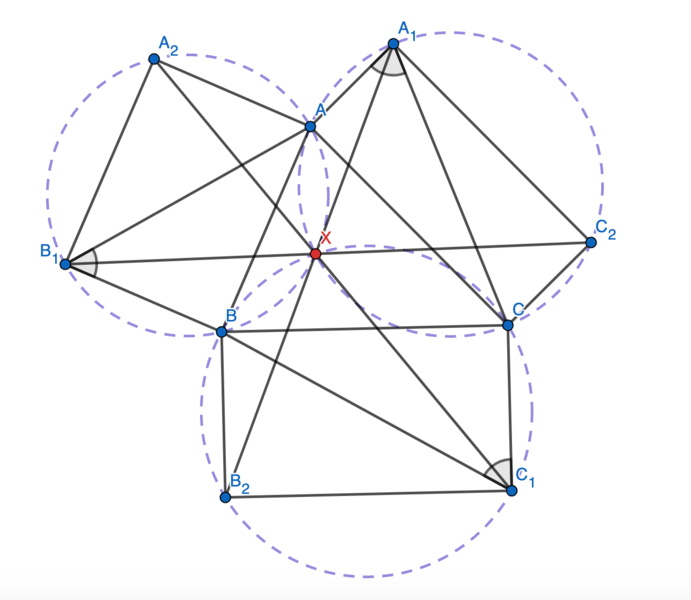- 翰林提供学术活动、国际课程、科研项目一站式留学背景提升服务!
- 400 888 0080
【全网首发】2021USAJMO 真题及答案
【全网首发】2021USAJMO 真题及答案
文末有答案
Problem 1
Let ![]() denote the set of positive integers. Find all functions
denote the set of positive integers. Find all functions ![]() such that for positive integers
such that for positive integers ![]() and
and ![]()
![]()
Problem 2
Rectangles ![]()
![]() and
and ![]() are erected outside an acute triangle
are erected outside an acute triangle ![]() Suppose that
Suppose that![]() Prove that lines
Prove that lines ![]()
![]() and
and ![]() are concurrent.
are concurrent.
Problem 3
An equilateral triangle ![]() of side length
of side length ![]() is given. Suppose that
is given. Suppose that ![]() equilateral triangles with side length 1 and with non-overlapping interiors are drawn inside
equilateral triangles with side length 1 and with non-overlapping interiors are drawn inside ![]() , such that each unit equilateral triangle has sides parallel to
, such that each unit equilateral triangle has sides parallel to ![]() , but with opposite orientation. (An example with
, but with opposite orientation. (An example with ![]() is drawn below.)
is drawn below.) Prove that
Prove that
Problem 4
Carina has three pins, labeled ![]() , and
, and ![]() , respectively, located at the origin of the coordinate plane. In a move, Carina may move a pin to an adjacent lattice point at distance
, respectively, located at the origin of the coordinate plane. In a move, Carina may move a pin to an adjacent lattice point at distance ![]() away. What is the least number of moves that Carina can make in order for triangle
away. What is the least number of moves that Carina can make in order for triangle ![]() to have area 2021?
to have area 2021?
(A lattice point is a point ![]() in the coordinate plane where
in the coordinate plane where ![]() and
and ![]() are both integers, not necessarily positive.)
are both integers, not necessarily positive.)
Problem 5
A finite set ![]() of positive integers has the property that, for each
of positive integers has the property that, for each ![]() and each positive integer divisor
and each positive integer divisor ![]() of
of ![]() , there exists a unique element
, there exists a unique element ![]() satisfying
satisfying ![]() . (The elements
. (The elements ![]() and
and ![]() could be equal.)
could be equal.)
Given this information, find all possible values for the number of elements of ![]() .
.
Problem 6
Let ![]() be an integer. Find all positive real solutions to the following system of
be an integer. Find all positive real solutions to the following system of ![]() equations:
equations:
Problem 1
Solution
I claim that the only function ![]() that satisfies the constraints outlined within the problem is the function
that satisfies the constraints outlined within the problem is the function ![]() for all positive integers
for all positive integers ![]() .
.
We will proceed with strong induction. The base case is simple, as plugging ![]() into the second equation given within the problem gives
into the second equation given within the problem gives ![]() . Since
. Since ![]() can only return a positive integer value, we have that
can only return a positive integer value, we have that ![]() .
.
Now we proceed with the inductive step. If the next number ![]() is either a perfect square or can be represented as a sum of two perfect squares, then obviously
is either a perfect square or can be represented as a sum of two perfect squares, then obviously ![]() , as it is either the product of two
, as it is either the product of two ![]() -values that are both equal to
-values that are both equal to ![]() from the inductive assumption or is the square of an
from the inductive assumption or is the square of an ![]() -value that is equal to
-value that is equal to ![]() , again due to the inductive assumption. Otherwise, we can use the Sum of Two Squares Theorem, which tells us that
, again due to the inductive assumption. Otherwise, we can use the Sum of Two Squares Theorem, which tells us that ![]() has at least one prime in its prime factorization that is
has at least one prime in its prime factorization that is ![]() and is raised to an odd power.
and is raised to an odd power.
Lemma 1: Given that ![]() and
and ![]() , we then have
, we then have ![]() .
.
Proof: Note that the first condition in the problem tells us that ![]() , or
, or ![]() . Using the second condition gives us
. Using the second condition gives us ![]() . Plugging in the values of
. Plugging in the values of ![]() and
and ![]() gives us that
gives us that ![]() .
.
Now we will attempt to repeatedly remove prime factors that are ![]() and taken to an odd power, and we will move from the largest prime down to the smallest prime that satisfies above conditions. The prime factors will be removed by constructing a Pythagorean Triple with the prime being the smallest leg in the form of
and taken to an odd power, and we will move from the largest prime down to the smallest prime that satisfies above conditions. The prime factors will be removed by constructing a Pythagorean Triple with the prime being the smallest leg in the form of  (this will always work as
(this will always work as ![]() (not 3 mod 4), and this method works via Lemma 1). We will then prove the ending numbers that we achieve via removing all the
(not 3 mod 4), and this method works via Lemma 1). We will then prove the ending numbers that we achieve via removing all the ![]() primes(which I will refer to as "tips") are equal to 1 b/c they can be expressed as the sum of two squares or is a perfect square(Sum of Two Squares Theorem). For example, if we took the number
primes(which I will refer to as "tips") are equal to 1 b/c they can be expressed as the sum of two squares or is a perfect square(Sum of Two Squares Theorem). For example, if we took the number ![]() , we would first aim to remove the
, we would first aim to remove the ![]() by splitting it into
by splitting it into ![]() and
and ![]() , so
, so ![]() would become
would become ![]() and
and ![]() .
. ![]() is divisible by
is divisible by ![]() to an odd power, so we transform it into
to an odd power, so we transform it into ![]() and
and ![]() . These two don't have any divisors that are
. These two don't have any divisors that are ![]() raised to an odd power so we leave it alone, as sum of two squares will work on them or they are perfect squares.
raised to an odd power so we leave it alone, as sum of two squares will work on them or they are perfect squares. ![]() does have a prime factor that is
does have a prime factor that is ![]() , but it is an even power so we leave it alone. In this case, the tips are
, but it is an even power so we leave it alone. In this case, the tips are ![]() ,
, ![]() , and
, and ![]() . However, now we need to prove two key facts: using this Pythagorean Triple Method will never generate another
. However, now we need to prove two key facts: using this Pythagorean Triple Method will never generate another ![]() prime that is bigger than the current one we are working on or create more primes or keep the same number of primes in the tips' prime factorizations., as otherwise it could cause an infinite cycle, and also we must prove when we use Sum of Two Squares/Perfect Square given in the second condition on the tips the square root of the square(s) used will never be greater than or equal to
prime that is bigger than the current one we are working on or create more primes or keep the same number of primes in the tips' prime factorizations., as otherwise it could cause an infinite cycle, and also we must prove when we use Sum of Two Squares/Perfect Square given in the second condition on the tips the square root of the square(s) used will never be greater than or equal to ![]() .
.
The first claim can be proved rather simply. Note that  can have no prime factors greater than or equal to
can have no prime factors greater than or equal to ![]() , as it can be factored as
, as it can be factored as  , which are both less than
, which are both less than ![]() and are integers(
and are integers(![]() must be an integer due to
must be an integer due to ![]() must being odd(not equal to
must being odd(not equal to ![]() )). For
)). For  , we can prove something a bit more general.
, we can prove something a bit more general.
Lemma 2: For any positive integer ![]() , all prime factors of
, all prime factors of ![]() must be
must be ![]() .
.
Proof: Note that if ![]() , then we also must have
, then we also must have ![]() , or
, or ![]() . Now we can apply Fermat's Little Theorem to obtain
. Now we can apply Fermat's Little Theorem to obtain ![]() . Note that since
. Note that since ![]() and
and ![]() are obviously not
are obviously not ![]() , as
, as ![]() , we have that
, we have that ![]() is a multiple of
is a multiple of ![]() , or
, or ![]() .
.
We can simply apply Lemma 2 to ![]() as
as ![]() is obviously not
is obviously not ![]() , and this means that a prime factor
, and this means that a prime factor ![]() will never be generated from this term. This completes the first of our two claims.
will never be generated from this term. This completes the first of our two claims.
Now we proceed to the second of our two claims. Note that every time we use the method on ![]() based on prime
based on prime ![]() , we will multiply by around
, we will multiply by around ![]() , clearly less than
, clearly less than ![]() (if we multiply by
(if we multiply by ![]() we would get
we would get ![]() which is clearly greater than
which is clearly greater than  ). We will never have to use the same prime twice in our method, so at max in the end we will multiply
). We will never have to use the same prime twice in our method, so at max in the end we will multiply ![]() by the product of a little less than all
by the product of a little less than all ![]() primes that divide it, which is less than
primes that divide it, which is less than ![]() itself for
itself for ![]() greater than or equal to
greater than or equal to ![]() (the smallest 3 mod 4 prime), meaning that the largest number that we must use two squares on that is generated by out method is less than
(the smallest 3 mod 4 prime), meaning that the largest number that we must use two squares on that is generated by out method is less than ![]() . We need to prove that the two squares that sum to this are both less than
. We need to prove that the two squares that sum to this are both less than ![]() , which is quite trivial, as they are less than
, which is quite trivial, as they are less than ![]() , which obviously means it must be less than
, which obviously means it must be less than ![]() . This proves the second of our claims.
. This proves the second of our claims.
This completes the second case of the inductive step, and therefore completes both the induction and the problem. ~Solution by hyxue
Solution 2 (Taken from Twitch Solves ISL)
The Answer is  which works but we want to prove that it's the only one. Claim: If
which works but we want to prove that it's the only one. Claim: If ![]() and a>b, then
and a>b, then ![]() . Proof: We can write
. Proof: We can write  . We set it to
. We set it to ![]() and we get that
and we get that ![]() . Easily by Induction it shows f(n)=1. We take if
. Easily by Induction it shows f(n)=1. We take if ![]() take
take ![]() which
which ![]() . If
. If ![]() , just take
, just take ![]() which
which ![]() . Thus the only answer is
. Thus the only answer is  and we are done.
and we are done.
Solution 3 (clear Solution 2)
The answer is  , which works. To show it is necessary, we first get
, which works. To show it is necessary, we first get ![]() , so
, so ![]() . Then, we get
. Then, we get ![]() .
.
The following claim finishes the problem via induction:
Claim: If ![]() for
for ![]() , we have
, we have ![]() .
.
Proof: Note that ![]() , so
, so![]() implies
implies ![]() .
.
Note that ![]() , so
, so![]() implies
implies ![]() .
. ![]()
Thus, the only solution is  .
.
Problem 2
Solution
We first claim that the three circles ![]()
![]() and
and ![]() share a common intersection.
share a common intersection.
Let the second intersection of ![]() and
and ![]() be
be ![]() . Then
. Then which implies that
which implies that ![]() is cyclic as desired.
is cyclic as desired.
Now we show that ![]() is the intersection of
is the intersection of ![]()
![]() and
and ![]() Note that
Note that ![]() so
so ![]() are collinear. Similarly,
are collinear. Similarly, ![]() and
and ![]() are collinear, so the three lines concur and we are done.
are collinear, so the three lines concur and we are done.
Problem 4
Solution 1
The answer is ![]() , achievable by
, achievable by ![]() . We now show the bound.
. We now show the bound.
We first do the following optimizations:
-if you have a point goes both left and right, we may obviously delete both of these moves and decrease the number of moves by ![]() .
.
-if all of ![]() lie on one side of the plane, for example
lie on one side of the plane, for example ![]() , we shift them all down, decreasing the number of moves by
, we shift them all down, decreasing the number of moves by ![]() , until one of the points is on
, until one of the points is on ![]() for the first time.
for the first time.
Now we may assume that ![]() ,
, ![]() ,
, ![]() where
where ![]() . Note we may still shift all
. Note we may still shift all ![]() down by
down by ![]() if
if ![]() , decreasing the number of moves by
, decreasing the number of moves by ![]() , until one of
, until one of ![]() is on
is on ![]() for the first time. So we may assume one of
for the first time. So we may assume one of ![]() and
and ![]() is
is ![]() , by symmetry. In particular, by shoelace the answer to 2021 JMO Problem 4 is the minimum of the answers to the following problems:
, by symmetry. In particular, by shoelace the answer to 2021 JMO Problem 4 is the minimum of the answers to the following problems:
Case 1 (where ![]() ) if
) if ![]() , find the minimum possible value of
, find the minimum possible value of ![]() .
.
Case 2 (else) ![]() , find the minimum possible value of
, find the minimum possible value of ![]() .
.
Note that ![]() so if
so if ![]() is fixed then
is fixed then ![]() is maximized exactly when
is maximized exactly when ![]() is minimized. In particular, if
is minimized. In particular, if ![]() then
then ![]() as desired.
as desired.

最新发布
© 2025. All Rights Reserved. 沪ICP备2023009024号-1










